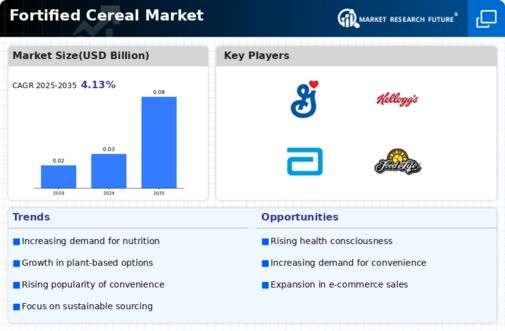Fortified Cereal Size
Fortified Cereal Market Growth Projections and Opportunities
The fortified cereal market is influenced by several key factors that shape its growth and dynamics. One of the primary drivers of this market is the increasing consumer demand for convenient and nutritious breakfast options. Fortified cereals, enriched with vitamins, minerals, fiber, and other nutrients, cater to consumers seeking convenient ways to improve their nutritional intake and support overall health and wellness. As busy lifestyles and hectic schedules become increasingly common, consumers are turning to fortified cereals as a quick and easy breakfast choice that offers both convenience and nutritional benefits.
Economic factors also play a significant role in shaping the fortified cereal market. Fluctuations in disposable income levels and consumer spending patterns can impact purchasing power and the willingness to invest in premium fortified products. However, despite potential economic downturns, the demand for functional foods like fortified cereals remains resilient, as consumers prioritize their health and seek value-added food options that offer both convenience and nutritional benefits.
Regulatory policies and standards are critical factors influencing the fortified cereal market. Compliance with food labeling regulations and nutrient content claims is essential for cereal manufacturers to accurately market their fortified products. Additionally, regulations governing the fortification of foods with specific nutrients, such as vitamins and minerals, vary by region and must be adhered to ensure product safety and efficacy. Meeting these standards is crucial for maintaining consumer trust and confidence in fortified cereals.
Technological advancements also impact the fortified cereal market, particularly in fortification and production technologies. Innovations in fortification methods, such as microencapsulation and extrusion, can improve the stability and bioavailability of added nutrients in cereals. Additionally, advancements in cereal processing technologies enable manufacturers to incorporate fortified ingredients seamlessly into a variety of cereal formulations without compromising taste or texture.
Competitive dynamics and market competition are significant factors in shaping the fortified cereal market. Established brands with strong market presence and distribution networks may dominate shelf space and consumer preferences, making it challenging for new entrants to gain traction. However, innovative startups and niche players can differentiate themselves with unique fortification formulations and marketing strategies, targeting specific consumer segments seeking functional cereals tailored to their nutritional needs.
Changing consumer preferences and dietary trends also influence the fortified cereal market. As consumers become more health-conscious and seek out foods that support their specific health goals, there is a growing demand for fortified cereals targeting various health concerns, such as heart health, digestive health, or weight management. Additionally, dietary trends such as gluten-free, low-sugar, or plant-based diets have fueled interest in fortified cereals that cater to these dietary preferences and restrictions.
Moreover, demographic trends such as aging populations and increasing health awareness among younger generations have contributed to the growth of the fortified cereal market. Older consumers may seek out fortified cereals to address age-related health concerns, while younger consumers prioritize functional foods as part of a proactive approach to health and wellness.








Leave a Comment